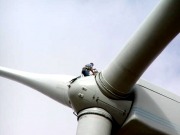
Curtis Berlinguette and Simon Trudel, two researchers in the Chemistry Department at the University of Calgary Faculty of Science, have developed a unique and inexpensive method of storing energy by using rust as a catalyst for water electrolysis.
The new technology means that homeowners and energy companies could easily store and reuse electricity generated by solar PV and wind power. Their research study has just been published in the journal Science and, according to Trudel, it opens up a completely new way in which to make catalytic materials.
“This breakthrough offers a relatively cheaper method of storing and reusing electricity produced by wind turbines and solar panels,” said Berlinguette, Associate Professor of Chemistry and Canada Research Chair in Energy Conversion. “Our work represents a critical step for realizing a large-scale, clean energy economy.”
The two scientists have now patented their technology and created a spin-off company called FireWater Fuel Corp in order to commercialize their electrocatalysts for use in electrolyzers. These devices use catalysts in order to create a chemical reaction which then converts electricity into chemical energy by splitting water into hydrogen and oxygen. These two gases can then be stored and re-converted to electricity according to demand whenever it is needed. The only by-product from the process is water which can itself be recycled through the system. A typical house would only need an electrolyzer the size of a fridge which would have virtually zero emissions.
Typically, catalysts are made from rare metals in a crystalline structure. These metals are often expensive and toxic. However, Berlinguette and Trudel used abundant metal compounds or oxides – including rust (iron oxide) – to create mixed metal oxide catalysts with a disordered or amorphous structure which perform just as well or even better than catalysts currently on the market but at much less cost.
FireWater Fuel Corp is hoping to have a commercial product available in the large-scale electrolyzer market in 2014 and a prototype electrolyzer, ready for testing in a home, by 2015.
Further information:
Could this then work both ways and act as a Hydrogen Fuel Cell; create electricity by converting hydrogen and oxygen into water?

